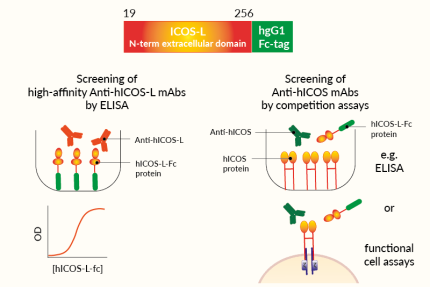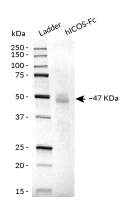hICOS-L-Fc
-
Cat.code:
fc-hicosl
- Documents
ABOUT
Soluble human ICOS-L (CD275) fused to an IgG1 Fc domain
Protein description
InvivoGen offers hICOS-L-Fc, a soluble human ICOS-L (CD275) chimera protein generated by fusing the N-terminal extracellular domain of human ICOS-L (aa 19-256) to the N-terminus of a human IgG1 Fc domain with a TEV (Tobacco Etch Virus) sequence linker.
hICOS-L-Fc has been produced in CHO cells and purified by affinity chromatography. It has an apparent molecular weight of ~70 kDa on an SDS‑PAGE gel.
ICOS-L background
Inducible Co-Stimulator Ligand (ICOS-L), also known as cluster of differentiation 275 (CD275) is a Type I transmembrane protein that is mostly expressed by antigen-presenting cells. ICOS-L is classified as an immunostimulatory immune checkpoint. It binds ICOS (CD278) which is rapidly induced in CD4+ and CD8+ T cells upon their activation [1].
Applications
- Screening of high-affinity anti-human ICOS-L monoclonal antibodies by ELISA
- Screening of anti-human ICOS monoclonal antibodies using competition assays
Quality control
- Size and purity confirmed by SDS-PAGE
- Protein validated by ELISA using an anti-hICOS-L monoclonal antibody
- Protein validated by flow cytometry using Jurkat-Lucia™ hICOS cells
- Protein potency at triggering intracellular signaling validated using Jurkat-Lucia™ hICOS cells
Reference
1. Amatore F et al. 2020. Role of ICOS in cancer immunotherapy. Expert Opin Biol Ther 20:141-150.
All InvivoGen products are for internal research use only, and not for human or veterinary use.
InvivoGen also offers:
SPECIFICATIONS
Specifications
NP_001382847.1
Solution in sodium phosphate buffer with glycine, saccharose and stabilizing agents
ELISA, Flow cytometry, Intracellular signaling assays
Each lot is functionally tested and validated.
CONTENTS
Contents
-
Product:hICOS-L-Fc
-
Cat code:fc-hicosl
-
Quantity:50 µg
1.5 ml of endotoxin-free water
Shipping & Storage
- Shipping method: Room temperature
- -20°C
- Avoid repeated freeze-thaw cycles
Storage:
Caution:
Details
Inducible Co-Stimulator Ligand (ICOS-L), also known as cluster of differentiation 275 (CD275) is a transmembrane protein that is mostly expressed by antigen-presenting cells. ICOS-L is classified as an immunostimulatory immune checkpoint. It binds ICOS (CD278) which is rapidly induced in CD4+ and CD8+ T cells upon their activation [1]. The interaction between ICOS and ICOS-L delivers a secondary co-stimulatory signal through the activation of the transcription factor AKT, which promotes T cell proliferation and differentiation as well as the production of cytokines [1]. In tumor immunity, ICOS is involved in the amplification of the anti-tumor cytotoxic CD8+ T cell response, as well as the 'pro-tumor' function and maintenance of regulatory T cells (Tregs). Therefore, both agonistic and antagonistic monoclonal antibodies (mAbs) targeting this pathway are being investigated in combinational cancer immunotherapy [2]. Notably, ICOS agonistic mAbs have been shown to potentiate the effects of anti-CTLA4 mAbs [3].
References:
1. Amatore, F. et al. 2020. Role of ICOS in cancer immunotherapy. Expert Opin Biol Ther 20, 141-150.
2. Solinas, C. et al. 2020. The rationale behind targeting the ICOS-ICOS ligand costimulatory pathway in cancer immunotherapy. ESMO Open 5.
3. Soldevilla, M.M. et al. 2019. ICOS Costimulation at the Tumor Site in Combination with CTLA-4 Blockade Therapy Elicits Strong Tumor Immunity. Mol Ther 27, 1878-1891.
DOCUMENTS
Documents
Technical Data Sheet
Validation Data Sheet
Safety Data Sheet
Certificate of analysis
Need a CoA ?






